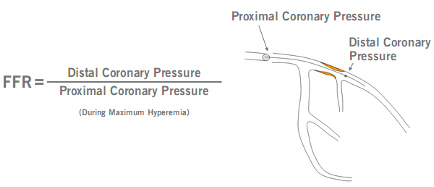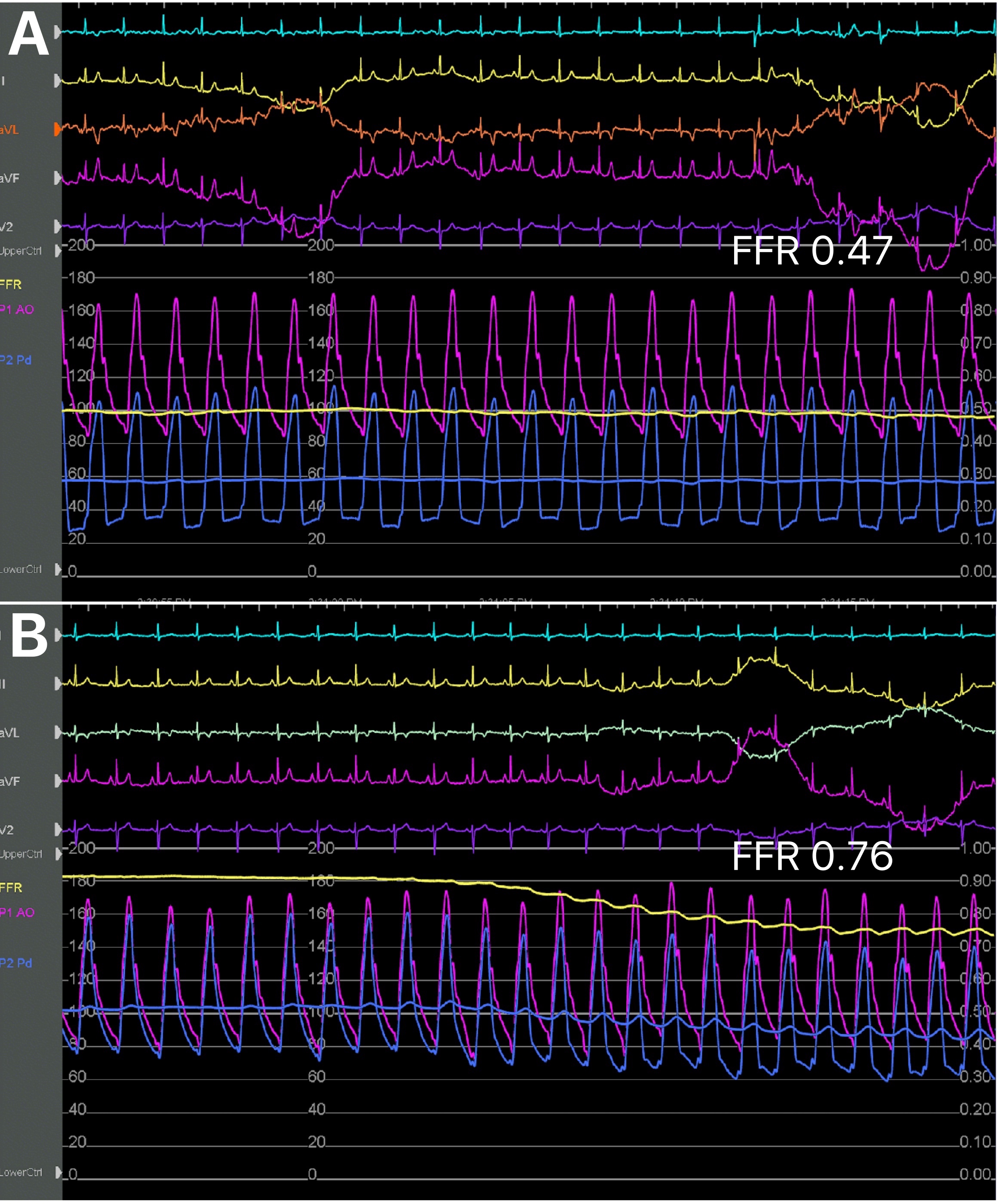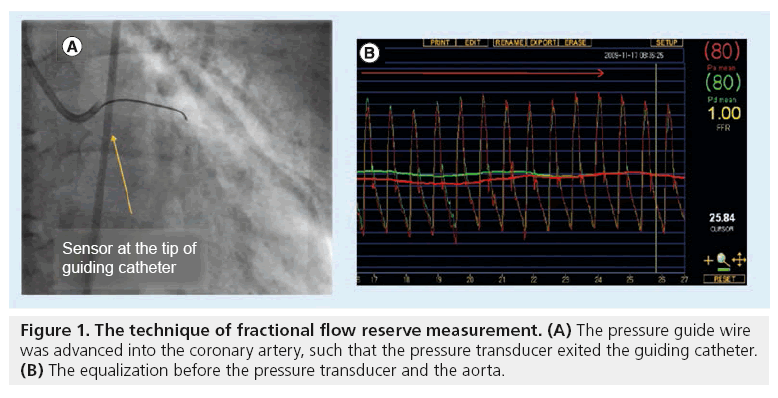fractional flow reserve test
To evaluate lesion-specific ischemia FFRCT is measured 2 cm distal to a stenotic lesion. Fractional Flow Reserve FFR will be performed at the same time as your coronary angiogram.

How Is A Fractional Flow Reserve Measured
FFRCT greater than 08 is normal 07608 is borderline and 075 or less is abnormal.

. In most cases the seriousness of the stenosis is. A recommendation to perform FFR in angiographically intermediate stenoses in the absence of stress testing or in the presence of discordant stress test results and. Fractional Flow Reserve FFR Maximum flow down a.
In this study the grid independence test was carried out and the maximum grid size of the model gradually changed to 90 of the. Narrowing or blockages in these arteries is called coronary artery disease. Complications include coronary vessel perforation embolism infection in the site spasm of the blood vessel kidney failure heart attack stroke and serious arrhythmias irregular heartbeat.
The decision to perform a percutaneous coronary intervention PCI is usually based on angiographic results alone. Randomized clinical trials have reported improved. It might be the case that a novel non-invasive test is actually more accurate and provides more prognostic value than FFR but loses research interest because initial comparisons.
Ct Angiogram Fractional Flow Reserve Ctffr. Coronary FFR is higher in women than men for any given stenosis due to smaller. Fractional flow reserve FFR measurement involves determining the ratio between the maximum achievable blood flow in a diseased coronary artery and the theoretical maximum flow in a normal coronary artery to determine the likelihood that the stenosis impedes oxygen delivery to the heart muscle.
This procedure involves inserting a very thin guide wire through a diagnostic catheter into your groin or wrist and up into your coronary artery. Measuring blood flow in the hearts coronary arteries. A fractional flow reserve FFR is a procedure done during cardiac catheterization to estimate the degree of blockage in the coronary arteries.
FFR is the ratio of the. These arteries bring oxygen-rich blood to the heart to be pumped throughout the rest of the body. This test may be considered medically necessary when CCTA shows coronary artery disease CAD of uncertain functional.
Noninvasive estimated coronary fractional flow reserve FFR derived from coronary computed tomography angiography data using computation fluid dynamics physiologic simulation software. 101148ryct2019190050 PMC free article PubMed CrossRef Google Scholar. Angiography can be used for the visual evaluation of the inner diameter of a vessel.
The University of Chicago Medicine is one of a few hospitals using fractional flow reserve derived from CT FFRCT a new advanced technology that provides detailed information about your heart and how blood flows through your arteries. Fractional Flow Reserve 075 Exercise Test Thallium Scan Stress Echo Pijls et al New EnglJ Med 19963341703 FFR in Intermediate LesionsFFR in Intermediate Lesions FFR 075. Angiography-derived Fractional Flow Reserve Testing in Patients with Stable Coronary Artery Disease.
An FFR of 10 is widely accepted as normal. Fractional flow reserve FFR is an invasive procedure used during coronary angiography to determine the functional significance of coronary stenoses. The invasive measurement of fractional flow reserve FFR can determine the haemodynamic relevance of coronary artery stenoses.
Sensitivity 88 Specificity 100. Fractional flow reserve FFR measurement involves determining the ratio between the maximum achievable blood flow in a diseased coronary artery and the theoretical maximum flow in a normal coronary artery. We sought to determine the correlation between cardiac stress testing and coronary fractional flow reserve FFR measurement for assessing the presence location and burden of myocardial ischemia in patients referred for evaluation of coronary artery disease CAD.
Background Fractional flow reserve FFR defined as the ratio of maximum flow in the presence of a stenosis to normal maximum flow is a lesion-specific index of stenosis severity that can be calculated by simultaneous measurement of mean arterial distal coronary and central venous pressure P a P d and P v respectively during. In ischemic heart disease deciding which narrowing is the culprit lesion is not always clear-cut. An FFR lower than 075-080 is generally considered to be associated with.
FFR uses a small sensor on the tip of the wire to measure blood pressure and flow in your artery. Fractional flow reserve provides a functional evaluation by measuring the pressure decline caused by a vessel narrowing. Currently fractional flow reserve FFR is an effective technique to functionally evaluate the significance of coronary artery stenosis but its clinical application was limited by its invasive operation.
This test makes it possible to reduce the need for invasive procedures and reach a confident. Fractional flow reserve also known as FFR is a measurement of how well blood can flow through the coronary arteries. Fractional flow reserve FFR is an invasive measurement developed in 1990s for evaluation of functional significance of stenoses in the epicardial coronary artery.
Diagnostic technology continues to advance and the CT angiogram fractional flow reserve or CTFFR test has proven to be of great value as a non-invasive way to diagnose the underlying cause of chest pain. Yes fractional flow reserve FFR testing is useful in both men and women. The coronary pressure wire is a small wire with a pressure sensor near its tip that can be placed beyond the moderate narrowing.
The fractional flow reserve FFR has emerged as an important addition to coronary angiography for clinical decision-making in ischemic heart disease IHD 3 4. Fractional flow reserve FFR is an invasive procedure used during coronary angiography to determine the functional significance of coronary stenoses. Determination of FFR is recommended in coronary artery stenoses with a luminal diameter narrowing between 50 and 90 if no non-invasive proof of ischaemia is available To measure the FFR of a given coronary lesion a wire.
This blockage or narrowing called stenosis reduces the amount of blood that can flow through your vessels. An FFR of 10 is widely accepted as normal. The Fractional Flow Reserve Versus Angiography for Multivessel Evaluation FAME trial showed that both men and women derived benefit from the use of FFR to guide decisions regarding PCI.
FFRCT should always be interpreted in. Fractional Flow Reserve FFR Fractional flow reserve FFR is an index that can be measured with a coronary pressure wire in a patient with a moderate narrowing of unclear significance. Recommendations on Interpretation and Reporting.
Reduced blood flow can lead to a heart attack or arrhythmias irregular heartbeats. Noninvasive stress test exercise testing stress echocardiography or single photon emission computed tomography myocardial perfusion image is recommended by current. Its use is particularly helpful in intermediate or angiographically ambiguous lesions in the absence of noninvasive functional studies.
FFRCT identifies exactly where low blood flow exists and indicates how severe the. Radiol Cardiothorac Imaging 2019. Fractional flow reserve FFR can help your doctor make that decision when the visual images from an angiogram and sometimes the results of stress testing do not provide clear guidanceFFR which is measured during an angiogram using a thin pressure wire gauges the impact of plaque build-up by comparing the pressure in the artery beyond the.
Fractional flow reserve FFR is a diagnostic test that measures the blood flow in a diseased artery. CT fractional flow reserve FFRCT is a physiologic simulation technique that models coronary flow from routine coronary CT angiography CTA.

Multivessel Percutaneous Coronary Intervention Guided By Fractional Flow Reserve Radcliffe Cardiology

Fractional Flow Reserve Ffr Fractional Flow Reserve Ffr Is Used By Apollo Gleneagles Medium

Accuracy Of Intravascular Ultrasound Based Fractional Flow Reserve In Identifying Hemodynamic Significance Of Coronary Stenosis Circulation Cardiovascular Interventions

Fractional Flow Reserve Simple Knowledge Base

Use Of Fractional Flow Reserve In Acs American College Of Cardiology

Fractional Flow Reserve Ffr In The Presence Of Serial Stenoses In A Download Scientific Diagram

Fractional Flow Reserve Ffr Baseline Pressure Distal Pd And Aortic Download Scientific Diagram

Fractional Flow Reserve Ffr Cathlab Com

Fractional Flow Reserve Coronary Flow Reserve Imr Microvascular Resistance

Concept Of Fractional Flow Reserve Fractional Flow Reserve Ffr Is Download Scientific Diagram

Impact Of Hydrostatic Pressure On Fractional Flow Reserve In Vivo Experimental Study Of Anatomical Height Difference Of Coronary Arteries Journal Of Cardiology

Fractional Flow Reserve An Overview Sciencedirect Topics

Non Invasive Ffr Ct Reduces Invasive Tests In Chest Pain Patients Daic

Fda Clears Abbott S New Ffr Coronary Lesion Assessment Technology Daic

Invasive Fractional Flow Reserve Ffr In The Catheter Laboratory To Download Scientific Diagram

Fractional Flow Reserve A New Paradigm For Diagnosis And Management Of Patients With Coronary Artery Disease

Ct Fractional Flow Reserve A Practical Guide To Application Interpretation And Problem Solving Radiographics
The Evolving Story Of Fractional Flow Reserve Ct Cardiac Interventions Today

The Distribution Of Values For Fractional Flow Reserve Ffr Download Scientific Diagram